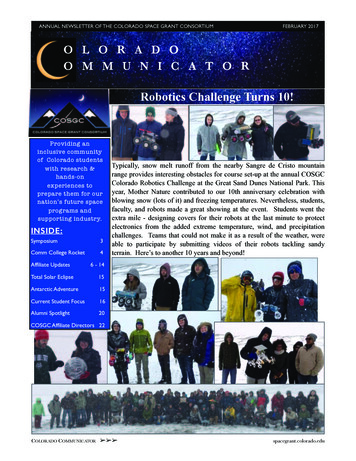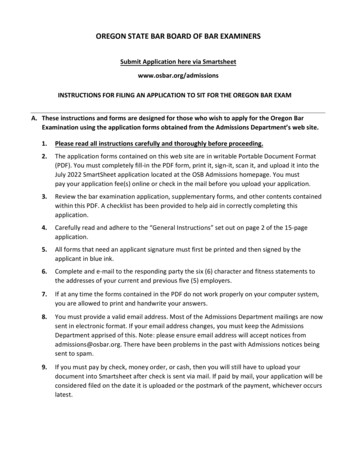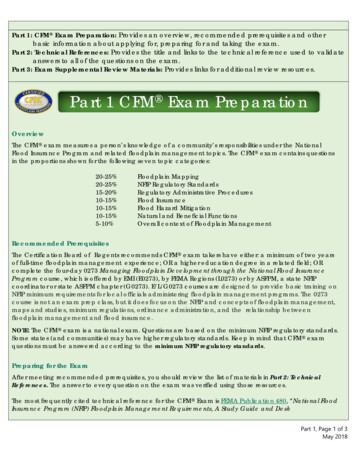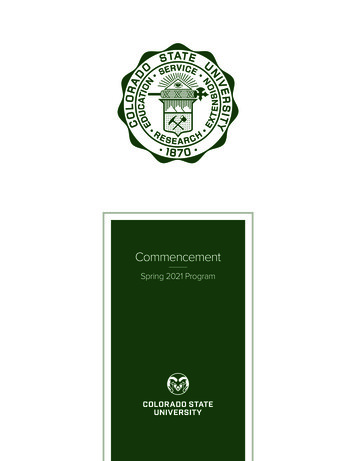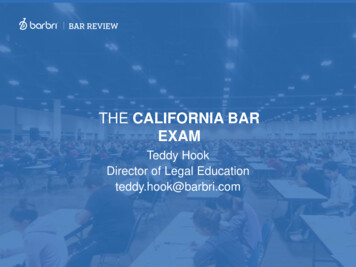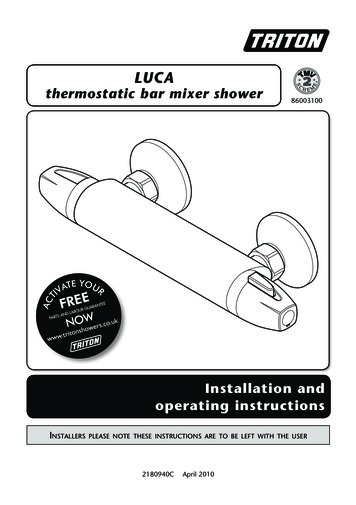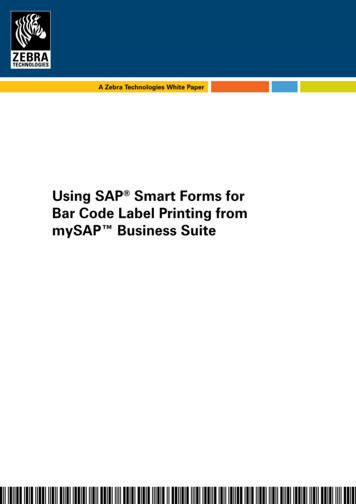
Transcription
QUESTION 1After a successful negotiation with counsel for an insurance company regarding a pendinglawsuit, the insurer issued a check for 30,000 drawn on First Federal Bank. The check was madepayable to Paula Plaintiff and Larry Lawyer. Lawyer was Plaintiff’s attorney in the suit. The insurermailed the check to Lawyer, and when Lawyer received the check, he indorsed his name on the back ofthe check and also signed Plaintiff’s name. Lawyer then deposited the check in his lawyer’s trust accountat Second State Bank. Second State Bank presented the check to First Federal Bank and receivedpayment. The 30,000 was then credited to Lawyer’s trust account.A few days later, Lawyer withdrew all the funds from the account. Under a valid contingency feeagreement, Lawyer was entitled to one-third of any amount collected in the lawsuit. Lawyer has neverremitted any portion of the settlement proceeds to Plaintiff. Second State Bank did not have any reasonto suspect Lawyer’s withdrawal of funds from the trust account was improper.QUESTION:Discuss whether Plaintiff can recover any of the 30,000 from Second State Bank. Do notdiscuss any potential actions that Plaintiff might be able to bring against Lawyer.QUESTION 2Wilma and Harold are residents of Colorado. After ten years of marriage, Wilma brought adissolution action against her husband, Harold, claiming the marriage was irretrievably broken.Harold recently received his degree in medicine and is a resident physician in a local hospital.Wilma has one year of college and has spent the bulk of her time during the marriage caring for thecouple’s home and their eight-year-old son, John. The couple’s principal asset is the house in which theyhave lived since their marriage. Harold purchased the house before the marriage with 150,000 hereceived from the sale of a house that he had inherited. The house remains titled in Harold’s name aloneand has a current market value of 250,000.QUESTIONS:1.2.3.4.Discuss Wilma’s interest in the house, if any.Discuss Wilma’s interest in Harold’s medical degree, if any.Discuss whether Wilma can receive maintenance from Harold. (Do not discuss howmaintenance would be calculated.)Discuss Harold’s obligation to pay child support and whether he has an obligation to payJohn’s college expenses when the time comes for John to attend college.QUESTION 3Greenacre is a twenty acre parcel of vacant rural land owned by Owner. It is bounded on threesides (north, west, and south) by a county wildlife preserve. The preserve is secured by a high chain linkfence around its entire perimeter. Along Greenacre’s east boundary lies County Road #1, the parcel’sonly public access road.In 1989, Owner sold and conveyed the east half of Greenacre to Buyer. After the closing, Buyerproceeded to build and permanently maintain a high chain link fence around the entire boundary of hisproperty. Owner retained no access easement benefitting the western half of Greenacre.Immediately after closing, Owner left the country and did not return to visit Greenacre until earlythis year. When he returned, Owner discovered Buyer’s fence denying access to the county road fromOwner’s parcel.Today, Owner read in the newspaper that the county had contracted to build a new public roadthrough the wildlife preserve late in 2006. This new road will abut Owner’s half of Greenacre.
QUESTIONS:Assume that the local statute of limitations (statutory period) is ten years in all civil matters.1.2.3.Discuss whether Owner has any right of access to his parcel.Discuss the legal effect, if any, of Owner’s nonuse of his parcel from 1989 to 2006.Discuss the legal effect, if any, of the proposed new county road on the rights of theparties.QUESTION 4Paula agreed to act as a promoter for a company to be known as Colorado Casting Corporation(CCC). Prior to the formation of CCC, Paula actively conducted negotiations with Larry, a local landowner, for the purchase of a parcel of land upon which to build CCC's headquarters. Paula explained toLarry that although CCC was still being organized, it was important to consummate the land purchase assoon as possible. The negotiations between Paula and Larry resulted in a signed agreement in whichLarry agreed to sell the land for 1,000,000. There was no reference of any kind to CCC in the body ofthe agreement. Paula signed the agreement as follows:Paula, principal organizer acting on behalf of ColoradoCasting Corporation, a corporation in the process ofbeing incorporated.After CCC had been properly formed and incorporated, CCC’s board of directors decided topurchase land on which to build its headquarters from another landowner at a price of 800,000. WhenLarry demanded that CCC perform under the agreement that had been entered into with Paula, CCCrefused.QUESTION:Discuss the rights and obligations of Paula, Larry, and Colorado Casting Corporation with respectto the agreement signed by Paula and Larry.QUESTION 5MegaHome hardware store recently contracted with an independent company called SqueakyClean to maintain the front entryway of its store during winter months. At 1:00 p.m. on a particularly coldand snowy February day, a customer, Paul, approached the front entryway of MegaHome and slipped ona large patch of ice which caused him to fall and break his leg. Four hours earlier that day, whenMegaHome first opened at 9 a.m., Larry, an employee of Squeaky Clean, removed all the snow from thefront entryway and applied an ice melting compound. Over the next three hours, Larry did not check theentryway or take any further action to make it safe. At noon, approximately one hour before Paul slipped,Larry saw the large ice patch and placed a small sign approximately twenty-five feet away that read“Caution.”Paul was so angry after he slipped that he threw his car keys at Larry intending to hit him. Thekeys flew past Larry and caused a minor crack in a glass lamp which another customer, Maggie, had justpurchased and was holding under her arm. Maggie did not see Paul throw the keys, as she was lookingin the opposite direction when they struck the lamp.QUESTIONS:1. Discuss any viable claim(s) that Paul might have against MegaHome.2. Discuss any viable claim(s) that Maggie might have against Paul.
QUESTION 6Mark Marketer, Cathy Coder, and Paul Programmer all lost their jobs when the internet companywhere they worked filed for bankruptcy protection. The three went to a coffee shop to commiserate.While at the coffee shop, Marketer looked out the window and remarked: “We should rob that bankacross the street.”Coder and Programmer agreed to participate in the robbery with Marketer. Coder walked downthe street to a gun store and purchased a pistol. Coder returned to the coffee shop and showed the pistolto Marketer and Programmer. Programmer became very nervous and told Marketer and Coder: “This isa bad idea, and I don’t want anything to do with it.” Programmer then walked out of the coffee shop.After Programmer left, Coder noticed an article in the newspaper which indicated that the bankacross the street had gone out of business two weeks earlier because it had made too many bad loans tointernet companies. Coder told Marketer the disappointing news. Marketer then walked out of the coffeeshop.A few minutes later, Coder wrote the following words on a napkin: “Give me a pound of coffee orI will shoot you.” Coder put the napkin in her pocket with the gun and began to walk toward the owner ofthe coffee shop. Just as Coder was about to hand the napkin to the coffee shop owner, an undercoverpolice officer intervened and arrested Coder, as the officer had overheard the three person’s discussion.QUESTION:Discuss any crime(s) that Programmer, Marketer, or Coder may have committed, and anypossible defense(s) or limitation(s) to each person’s criminal liability.QUESTION 7During his last illness, Tyler decided to make a will. He called his daughters, Alma, Beata, andCalla to his bedside. Because he was unable to write, Alma, in her own handwriting, wrote the text thather father dictated to her. Afterwards, Tyler signed the will in the presence of his children with an “X” atthe end of the text Alma had handwritten for him. The entire will read as follows:TYLER’S WILLI, Tyler, leave all of my estate to my children, share and share alike.X(Tyler’s mark)Tyler died the following day. He was survived by Alma, Beata, Calla and two sons, Dwayne, andEarl. Earl was born out of wedlock, the result of an extramarital affair. Dwayne had two sons, Mark andNathan, who also survived Tyler. Tyler’s wife had predeceased him several years earlier.Years earlier, after a family dispute, Dwayne had sent a signed letter to his father that stated, inpertinent part: “I want nothing more from you, including any inheritance.”Alma was appointed personal representative of Tyler’s estate which consists of real propertyvalued at 70,000, a bank savings account in the name of “Tyler in trust for Earl” in the amount of 5,000,and a certificate of deposit in the amount of 30,000 held in Tyler’s name. The letter from Dwayne toTyler was found by Tyler’s personal representative in the same strong box in which the deed to the realestate, bank savings account passbook, and certificate of deposit were found.QUESTION:
Discuss how Tyler’s estate will be distributed. Assume the Uniform Probate Code is in effect inthis jurisdiction and that Dwayne’s disclaimer is valid.QUESTION 8Tom Worker, a municipal employee, was called into his supervisor’s office and told he had beenfired from his job. No reasons were given for his firing.The relevant municipal ordinance regarding an employee’s dismissal provides that no employeecan be discharged except for "cause." The ordinance also provides that "employment is terminatedeffective upon the receipt by the employee of a written statement of the reason(s) for the dismissal."QUESTION:Discuss Worker’s right to a hearing and on what grounds he may challenge his dismissal.QUESTION 9Bill Buyer and Susana Seller are both citizens of the State of Fiction, a jurisdiction which followsmajority position common law. On a number of prior occasions, Buyer and Seller have had casualconversations regarding Buyer’s interest in purchasing Blackacre, a piece of real estate owned by Sellerand located in Fiction. Recently, Buyer called Seller and asked Seller if she would be willing to meet laterthat evening and discuss the purchase of Blackacre. Seller initially declined, indicating that she was sickand on medication. After some additional coaxing from Buyer, Seller agreed.Later that evening, Buyer and Seller met at a local pub. Seller initially did not drink because shewas not supposed to consume alcohol with her medication. As the evening progressed, Seller begandrinking and ultimately consumed several beers. After a couple of hours, Buyer turned the discussiontoward the potential purchase of Blackacre. Buyer asked Seller, “How much is it going to cost for me tobuy Blackacre from you?” Seller, who had a glazed look on her face, asked Buyer to repeat the question.Buyer did so. Seller leaned back, gazed up at the ceiling, and told Buyer that she would sell Blackacrefor 10,000. Buyer was shocked and excited because he believed the property to be worth at least 50,000. Buyer stuck out his hand to shake on the deal and exclaimed “you’ve got a deal.” Buyer tookout a pen and wrote on the back of a cocktail napkin that Seller had agreed to sell Blackacre to Buyer fora total purchase price of 10,000. Buyer dated the napkin and showed it to Seller. Seller nodded herhead in apparent agreement that the terms on the napkin accurately reflected the terms for the sale ofBlackacre. Buyer offered Seller 100 as a down payment toward the property. Seller accepted the 100,then the two shook hands again and left the bar.The next morning Buyer called Seller to discuss a date to complete the transaction which theyhad negotiated the night before. Seller told Buyer that she did not know what Buyer was talking about;she did not recall any of the events from the preceding night; and she had no intention of sellingBlackacre for 10,000.QUESTION:Discuss whether Seller must sell Blackacre to Buyer for 10,000.
DISCUSSION FOR QUESTION 1The check was a negotiable instrument. U.C.C. 3-103 and 104. A negotiable instrumentis one that is an: (a) unconditional (b) promise or order (c) to pay a fixed amount of money. Inorder to be negotiable, the instrument must be payable to order or bearer. U.C.C. 3-109. Here,the check is an order instrument, as it is payable to specific persons.In order to become a holder of an instrument, a person must be in possession with a rightto enforce it. When an instrument is payable jointly it can only be negotiated with theindorsements of each of the named payees. UCC 3-110(d). Unless all the joint payees indorsethe instrument, no person taking it up can be a holder or person entitled to enforce theinstrument. See, UCC 3-201 and 3-301.A bank converts an instrument if the bank pays it or gives value for it to a person who isnot entitled to enforce it. UCC 3-420; CRS 4-3-420(a). Here, Plaintiff may have a cause ofaction for conversion against Second State Bank. She was a joint payee of the insurer’s check.The instrument was payable to her and Lawyer. Her indorsement was therefore necessary topass title to the instrument. Second State Bank may have converted the instrument when it paidout the sums it collected against the check to Lawyer. The case will turn on whether Lawyer’ssigning of Plaintiff’s name was effective as Plaintiff’s signature.The Uniform Commercial Code recognizes that a person may be bound on an instrumentif an agent signs that person’s name. UCC 3-401(a). The Code relies on common law agencyprinciples in determining whether a represented person is bound by an agent’s use of theprincipal’s name. UCC 3-402(a). Several courts have held a client liable when an attorney signsthe client’s name on a negotiable instrument. See, e.g., Terry v. Kemper Insurance Company,390 Mass. 450, 456 N.E.2d 465 (1983); Hutzler v. Hertz Corporation, 39 N.Y.2d 209, 347N.E.2d 627 (1976). These cases reason that as between the client and a financial intermediarylike a bank, the client should bear the risk of the attorney’s defalcation. A contrary argument,however, can be made on agency principles. The attorney had no authority to sign the client’sname. The client also did nothing to cloak the attorney with apparent authority. See generally,Annotation, Discharge of Debtor Who Makes Payment by Delivering Check Payable to Creditorto Latter’s Agent, Where Agent Forges Creditor’s Signature and Absconds with Proceeds, 49A.L.R. 3d 843 (1973). The examinee should discuss the issue of whether or not Plaintiff’ssignature was authorized in evaluating potential weaknesses in the conversion claim.Even if a court finds Lawyer had no authority to sign Plaintiff’s name, the court couldnevertheless limit Plaintiff’s recovery to 20,000. Under UCC 3-420, liability is presumed to bethe amount payable on the check, Abut recovery may not exceed the amount of the plaintiff’sinterest in the instrument. Plaintiff is accepting the insurer’s offer of settlement. Lawyer wouldhave received 10,000 of the settlement even if he had not done anything wrong. At commonlaw, it was a defense to any claim on a negotiable instrument that the funds collected against theinstrument reached the intended payee. See, e.g., Florida National Bank v. Geer, 96 So.2d 409,412 (Fla. 1957). Second State Bank can argue 10,000 of the check reached the proper payee,Lawyer. Second State Bank could reach the same result under a subrogation theory. By payingLawyer, they would be entitled to Lawyer’s rights against Plaintiff. See, UCC 4-407; CRS 4-4407. In other words, Second State Bank can argue it acquired Lawyer’s right to his fee bysubrogation. The examinee should discuss this potential limitation on the amount of Plaintiff’srecovery in evaluating her claim.
DISCUSSION FOR QUESTION 21.Wilma does not have a valid claim for the home in which the couple have lived. It is notmarital property subject to division since it was acquired before the marriage; it is her husbandHarold’s separate property. Colo. Rev. Stat. 14-10-113(4). However, increases in separateproperty are considered marital property and therefore subject to an equitable and just division.Id.(1). Examinees should be given credit for noting that any assumption that a spousenecessarily is entitled to one-half of any marital property is incorrect; a spouse could be awardedmore or less or even none at all under Colorado’s equitable division. An unequal division couldbe equitable and within the court’s discretion. See In re Gercken, 706 P.2d 809 (Colo. App.1985). Accordingly, Wilma does not have a claim to the house but does have a claim to the 100,000 increase in value of the separate property during the marriage. How much of it shegets is within the court’s discretion, considering all relevant factors, including the relativeeconomic circumstances of the spouses.2.Wilma cannot have a portion of the value of her husband Harold’s degree. A spouse’sdegree is not marital property subject to division. In re Graham, 38 Colo.App. 130, 555 P.2d 527(1976), aff’d, 194 Colo. 429, 574 P.2d 75 (1978); In re Speirs, 956 P.2d 622 (Colo.App. 1997).A spouse’s education and the other spouse’s contribution to its being obtained are relevant indetermining the amount of child support and whether maintenance (alimony) will be ordered. Id.3.There are six guidelines a court must consider before a court can award maintenance.Those factors are: (1) Wilma has insufficient property, including her share of marital property, toprovide for her reasonable needs; (2) Wilma is unable to support herself through appropriateemployment; (3) the standard of living of the parties during the marriage; (4) Wilma’s age andphysical and emotional condition; (5) Wilma’s need to obtain additional education or training toget a job; and (6) the financial ability of Harold to pay maintenance. Maintenance awards aredone on a case by case basis and there is no statutory formula for determining the amount ofmaintenance. Colo. Rev. Stat. 14-10-114.4.The obligation to pay child support terminates upon emancipation or at age 19, whicheverfirst occurs. If a child is age 19 and still in high school, support continues until one monthfollowing graduation from high school. Harold cannot be required to pay for post secondaryeducation expenses. C.R.S. 14-10-115(1.6).DISCUSSION FOR QUESTION 31.Was any easement created when Greenacre was conveyed to Buyer?The common law doctrine of easements implied from necessity can only be invokedwhen (a) unity of title existed; (b) the parcel was severed (a larger parcel has been severed by anowner into smaller parcels and one or more of the resulting parcels is conveyed to another party);(c) the necessity for an easement came into existence at the moment of conveyance; and (d) thenecessity was caused by the severance of the larger parcel. These necessary conditions wouldhave been met in 1989 when Owner conveyed the east half of the parcel to Buyer. Stoebuck &Whitman, THE LAW OF PROPERTY, Third Ed. at 445 (West, 2000) (Stoebuck & Whitman).The necessity element has jurisdictional variations as to the level of necessity that willtrigger the doctrine. These variations run from (a) strict (or sheer) necessity to (b) reasonablenecessity to (c) significant need. In most jurisdictions Grantors such as Owner are held to ahigher level of necessity than Grantees such as Buyer because the Grantor made the transfer and
could have included a reservation of easement in their conveyance. Accordingly, courts arereluctant to award Grantors access easements by implied reservation which would burden thelands they conveyed to their Grantees without placing a written reservation in their deeds. Underthese facts most courts would hold Owner to a strict level of necessity (rather than the lesserrequirement of reasonable necessity often used to create easements for the benefit of theGrantee). But jurisdictional variations about strict-reasonable necessity will not matter underthese facts. This is so because the west half of Greenacre retained by Owner is landlocked unlessit enjoys an access easement across the east half to County Road #1. Being landlocked meets thehighest level of necessity in all jurisdictions. Stoebuck & Whitman, at 447-448.2.What is the legal effect on Owner’s rights of his nonuse of the west half of Greenacrefrom 1989 to 2006?If the required conditions for creating an Easement Implied from Necessity (unity of title,severance & conveyance, and necessity) all existed in 1989, then the mere nonuse of the impliedeasement by the dominant estate owner will not defeat the implied easement. The dominantowner’s property right in such an unused easement will lie dormant upon the servient estate untilneeded for the enjoyment of the dominant estate. Periods of dormancy can be decades long (andeven survive transfers of the servient and dominant estates to third parties, which is not an issuehere). Cribbet & Johnson, PRINCIPLES OF THE LAW OF PROPERTY, Third ed. at 372(Foundation Press, 1989) (Cribbet & Johnson).There can be no claim of adverse possession of Owner’s fee simple by Buyer based onthe stated facts. Buyer merely fenced his own land. Buyer never entered Owner’s fee simple oroccupied it openly, adversely, notoriously, exclusively, and continuously for the statutory period.Cribbett & Johnson at 334. The statute of limitations and its doctrines of adverse possession &prescription can legally terminate an easement that is in actual use. Hostile conduct visibly andadversely interfering with the use of the easement, such as blocking off an access easement, anddoing so continuously for the period of time prescribed by the statute of limitations could ripenprescriptive rights and terminate the easement. Such interference is necessary by the hostileservient estate owner such as Buyer. The mere nonuse of the easement by the owner of thedominant estate is not enough to terminate the easement. Examinees should nevertheless arguethe question whether Buyer’s construction and maintenance of his high chain link fence for overten years was sufficient. Cribbett & Johnson, at 378-79; Stoebuck & Whitman, at 468-69.The stated facts deal with a dormant implied easement which is not in actual use. The lawrespecting dormant easements and their termination by prescription is unsettled. Thus, the issuecould be argued both ways on the question of whether a dormant easement implied fromnecessity (such as Owner’s) can be terminated by prescription (such as Buyer fencing it off forthe statutory period of time).3.What is the legal effect of the proposed new county road?The duration of an Easement Implied from Necessity lasts only so long as the necessitythat created the easement continues to exist. Accordingly, should the planned new county roadactually be completed and opened at some future date, providing public access to Owner’s westhalf of Greenacre, then at that time the necessity that created an implied reservation of easementacross Buyer’s east half of Greenacre will have ended. This would result in the termination ofthe implied easement. Stoebuck & Whitman at 449; Cribbet & Johnson, at 373.
DISCUSSION FOR QUESTION 4Paula was acting as a promoter of CCC. Promoters are involved in the first steps offorming corporations in procuring commitments for capital and other instrumentalities that willbe used by the corporation after formation. Upon incorporation, promoters owe a fiduciary dutyto corporations and to those persons investing in them.The general rule states that if a person acts on behalf of a corporation, knowing that therehas been no incorporation, the person is jointly and severally liable for any obligations incurred.Revised Model Business Corporation Act (RMBCA) 2.04. Thus, Paula, as a promoter enteringinto agreements with third parties on behalf of the as of yet unformed Colorado CastingCorporation, is likely personally liable on pre-incorporation agreements.A promoter can avoid liability if she can establish that the other party to a preincorporation the agreement (1) knew that the corporation did not exist; and, (2) expressly agreedto look solely to the corporation when it was ultimately formed for performance under theagreement. Any number of authorities can be cited as standing for this general rule. Stanley J.How & Associates. Inc. v. Boss, 222 F. Supp. 936 (S.D. Iowa 1963); John A. Goodman v.Darden. Doman & Stafford Associates, 100 NW 2d 476 (1983); ROHRLICH ' 5.06(1).A promoter’s liability on pre-incorporation agreements continues after the corporation isformed, even if the corporation adopts the contract and benefits from it. The promoter’s liabilitycan be extinguished only if there is a novation an agreement among the parties releasing thepromoter and substituting the corporation. To clearly establish a novation, the third party shouldexpressly release the promoter after the corporation has adopted the contract. When a promoteris liable on a pre-incorporation contract and the corporation adopts the contract but no novationis agreed upon, the promoter may have the right to indemnification from the corporation if she issubsequently held liable on the contract. In this case, Larry did not sign a novation.Paula can’t claim an agency relationship since Colorado Casting did not yet exist at thetime of the agreement with Larry. A promoter can’t act as an agent of the corporation prior toincorporation; an agent can’t bind a nonexistent principal. Restatement (Second) of Agency 1(1957).The corporation can become bound by a promoter’s contracts through adoption. Theeffect of adoption is to make the corporation a party to the contract, although this in and of itselfdoesn’t relieve the promoter of her liability. ROHRLICH 5.06(1). In this case, when ColoradoCasting finally was formed and came into existence, it chose not to adopt the Paula/Larryagreement but chose instead to purchase land from another party. Therefore, Colorado Castingis not liable to Larry for performance under the agreementWhile it is clear that Larry knew that Colorado Casting was still being organized, therewas nothing in the body of the agreement that indicated that Larry would look solely to ColoradoCasting for performance under the agreement. In fact, the agreement contained no reference ofany kind to Colorado Casting. Furthermore, as we have already seen, Paula' signatory statementof purported representation of a nonexistent principal is without effect. Thus, Paula is liable toLarry for performance of the agreement.
DISCUSSION FOR QUESTION 5Paul’s claims against MegaHomePaul will have a valid claim of negligence against MegaHome. In order to recover on aclaim of negligence, a plaintiff must establish: (1) the existence of a legal duty to the plaintiff;(2) the defendant breached that duty; (3) the breach of duty caused the plaintiff injury; and (4)damages. See Keller v. Koca, 111 P.3d 445 (Colo. 2005); see also Restatement (Second) ofTorts, '' 281, 328A.Here, although MegaHome hired an independent contractor to clear its front entryway,MegaHome cannot delegate its duty to keep its premises safe for its customers. See Kidwell v.K-Mart Corp., 942 P.2d 1280 (Colo. App.1996)(obligation of landowner in possession ofproperty to maintain premises in safe condition for invitees may not be delegated to independentcontractor); Restatement (Second) of Torts, ' 422. Thus, MegaHome owed Paul a legal duty.Because Paul was a customer or business visitor, MegaHome’s duty toward Paul was that of aninvitee. See Restatement (Second) of Torts, ' 332. A landowner’s duty to an invitee includes theduty to warn the invitee of known dangerous conditions and a duty to make reasonableinspection of the premises to discover dangerous conditions and make them safe. The duty tomake a condition safe may be satisfied by a reasonable warning. See Benham v. King, 700N.W.2d 314 (Iowa 2005)(invitee owes duty to exercise reasonable care to determine actualcondition of premises, and if dangerous condition is discovered, invitees owes further duty tomake premises reasonably safe or warn of the condition and risk); Restatement (Second) ofTorts, ' 343. Some states no longer distinguish between invitees, licensees and trespassers andsimply use a reasonable person standard. See Dan B. Dobbs, The Law of Torts, pp. 615-620(2000). Examinees should receive credit for noting this trend.MegaHome breached its duty to Paul. Despite the fact that Larry initially tookreasonable steps to make sure the entryway was clear, he thereafter failed to take any additionalmeasures to clear the area during what the facts describe as a period of extremely cold andsnowy weather. And, although Larry eventually noticed the patch of ice, his act of placing asmall sign a long distance (twenty-five feet) away from the dangerous condition that simplystated Caution was probably insufficient to render the dangerous condition safe or to reasonablywarn Paul of its true nature, character, or risk.Because the remaining elements of proximate causation and damages are also satisfied,Paul appears to have a valid negligence claim against MegaHome.Maggie’s claims against PaulMaggie has viable claims against Paul for battery and trespass to chattels.1.BatteryBattery is defined as an intentional harmful or offensive contact to the plaintiff’s person.See Restatement (Second) of Torts, '' 13, 18. The plaintiff’s person may include anythingclosely connected to the person such as a purse or cane. See William L. Prosser, Law of Torts,p.34 (4th Ed. 1971); Fisher v. Carrousel Motor Hotel, Inc., 424 S.W.2d 627 (Tex. 1967).Here, the lamp which Maggie was holding under her arm was sufficiently attached orconnected to her person such that contact with the lamp could be deemed co
Clean to maintain the front entryway of its store during winter months. At 1:00 p.m. on a particularly cold and snowy February day, a customer, Paul, approached the front entryway of MegaHome and slipped on . Coder put the napkin in her pocket with the gun and began to walk toward the owner of the coffee shop. Just as Coder was about to hand .


